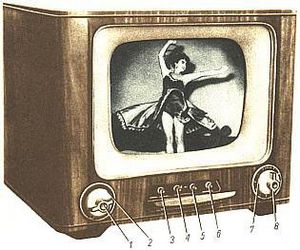Analog television facts for kids
Analog television or analogue television is the original television technology that uses analog signals to transmit video and audio. In an analog television broadcast, the brightness, colors and sound are represented by rapid variations of either the amplitude, frequency or phase of the signal.
The first commercial television systems were black-and-white; the beginning of color television was in the 1950s.
Analog signals vary over a continuous range of possible values which means that electronic noise and interference becomes reproduced by the receiver. With analog, a moderately weak signal becomes snowy and subject to interference. In contrast, a moderately weak digital signal and a very strong digital signal transmit equal picture quality.
Analog television may be wireless (terrestrial television and satellite television) or can be distributed over a cable network using cable converters (cable television).
All broadcast television systems used analog signals before the arrival of digital television (DTV). Motivated by the lower bandwidth requirements of compressed digital signals, since the 2000s a digital television transition is proceeding in most countries of the world, with different deadlines for the ending of analog broadcasts.
Common analog television systems:
Images for kids
-
NTSC composite video signal (analog)
-
Portion of a PAL videosignal. From left to right: end of a video line, front porch, horizontal sync pulse, back porch with colorburst, and beginning of next line
-
PAL video signal frames. Left to right: frame with scan lines (overlapping together, horizontal sync pulses show as the doubled straight horizontal lines), vertical blanking interval with vertical sync (shows as brightness increase of the bottom part of the signal in almost the leftmost part of the vertical blanking interval), entire frame, another VBI with VSYNC, beginning of the third frame












